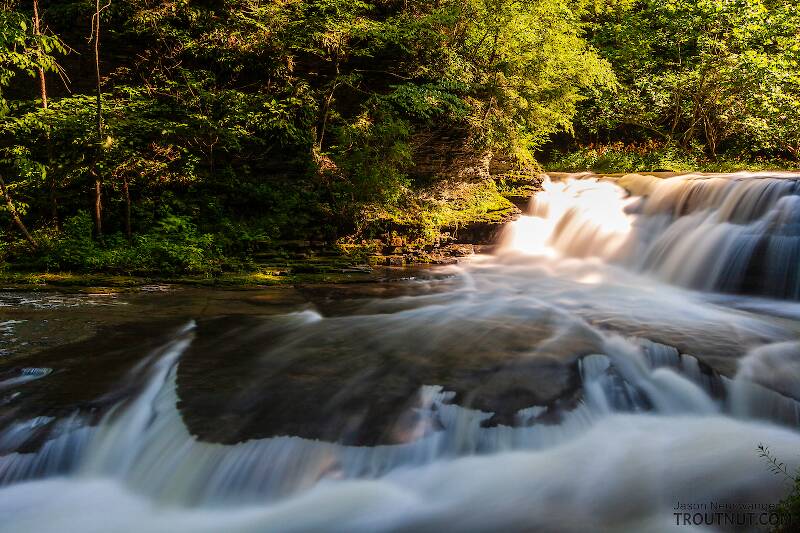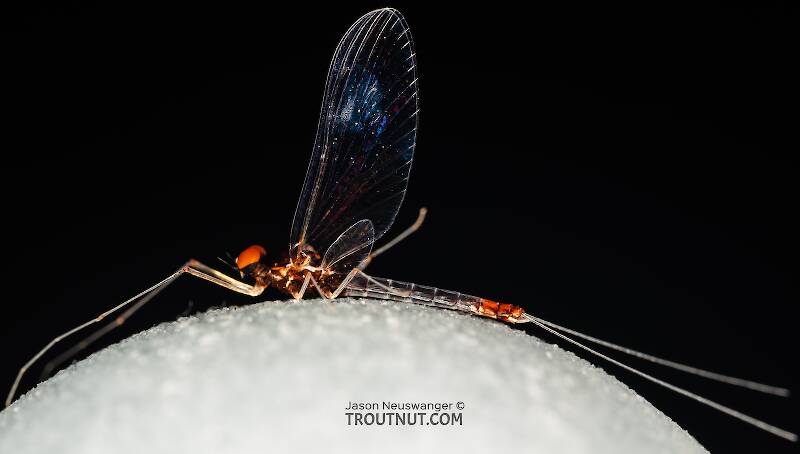
Hex Mayflies
Hexagenia limbata
The famous nocturnal Hex hatch of the Midwest (and a few other lucky locations) stirs to the surface mythically large brown trout that only touch streamers for the rest of the year.

I'm calling this one Pycnopsyche, but it's a bit perplexing. It seems to key definitively to at least Couplet 8 of the Key to Genera of Limnephilidae Larvae. That narrows it down to three genera, and the case seems wrong for the other two. The case looks right for Pycnopsyche, and it fits one of the key characteristics: "Abdominal sternum II without chloride epithelium and abdominal segment IX with only single seta on each side of dorsal sclerite." However, the characteristic "metanotal sa1 sclerites not fused, although often contiguous" does not seem to fit well. Those sclerites sure look fused to me, although I can make out a thin groove in the touching halves in the anterior half under the microscope. Perhaps this is a regional variation.
The only species of Pycnopsyche documented in Washington state is Pycnopsyche guttifera, and the colors and markings around the head of this specimen seem to match very well a specimen of that species from Massachusetts on Bugguide. So I am placing it in that species for now.
Whatever species this is, I photographed another specimen of seemingly the same species from the same spot a couple months later.

Mayfly Species Paraleptophlebia sculleni
Where & when
To my knowledge, this species has only been described in the scientific literature from the Oregon Cascades. However, on July 25th, I found several swarms of a dozen or so male spinners dancing above a gravel road/trail on the rim of a bouldery canyon at 2800 feet elevation on the eastern slope of the Washington Cascades.Although this canyon would easily constitute class 4+ whitewater when flows are higher, at typically low summer flows there are lots of quiet backwaters in the pools between the fast drops and boulders. This might be the habitat for the Paraleptophlebia nymphs.
I found them again a couple weeks later on the Middle Fork Snoqualmie River on the west slope of the Washington Cascades.
In 7 records from GBIF, adults of this species have been collected during June (43%), July (29%), and August (29%).
Species Range
Spinner behavior
The male spinners I encountered were flying right at dusk.Physical description
Most physical descriptions on Troutnut are direct or slightly edited quotes from the original scientific sources describing or updating the species, although there may be errors in copying them to this website. Such descriptions aren't always definitive, because species often turn out to be more variable than the original describers observed. In some cases, only a single specimen was described! However, they are useful starting points.
Male Spinner
Wing length: 6.5 mm
This is another brown and white, clear-winged species with black-ringed abdomen. Thorax brown above with paler sutural lines on the sides. Legs pale. Wings hyaline. Costal cross veins obsolete except in the creamy stigmatic area which covers costal and subcostal interspaces. Stigmatic cross veins few, simple, slightly curved.
Abdomen brown on segments 1 and 8 to 10; light brown on 2 and 7; white on 3 to 6, and on the base of 7, with blackish apical half-rings and lateral stripes that are darker at the postero-lateral angles of the segment. Ganglia and venter of segments 7 to 9 yellowish. The basal segment of the forceps tapers suddenly at the base, then very slightly to its tip. The penes are separated by an oval U-shaped notch, longest at the inner angle which projects rearward in a rounded lobe. Lateral to this lobe the apex is obliquely truncate, ending laterally in a minute recurved hook; the reflexed spurs are elongate, sickle-shaped and incurving at the tip (see fig. 133).
Specimens of the Mayfly Species Paraleptophlebia sculleni
2 Male Spinners
Start a Discussion of Paraleptophlebia sculleni
References
- Needham, James G., Jay R. Traver, and Yin-Chi Hsu. 1935. The Biology of Mayflies. Comstock Publishing Company, Inc.
Mayfly Species Paraleptophlebia sculleni
Species Range
Resources
- NatureServe
- Integrated Taxonomic Information System
- Global Biodiversity Information Facility
- Described by Traver (1934)



